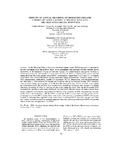| dc.identifier.citation | Mladenov, N. et al. (2005) Effects of annual flooding on dissolved organic carbon dynamics within a pristine wetland, the Okavango Delta, Botswana, Wetlands, Vol. 25, No. 3, pp. 622–638 | en_US |
| dc.description.abstract | In the Okavango Delta in Botswana, dissolved organic matter (DOM) transport is controlled by
the slow movement of an annual flood ‘pulse’ across permanently and seasonally flooded wetlands, known
respectively as the Permanent Swamp and Seasonal Swamp. We studied temporal and spatial variations in
fluorescence index (FI) and specific UV absorbance (SUVA) of DOM to identify DOM sources and fate
during the flood. Dissolved organic carbon (DOC) concentrations ranged from 2 to 25 mg C L21 in channels
of the Delta, with seasonal floodplains having consistently higher concentrations. Chemical indices, such as
DOC concentrations, conductivity, specific UV absorbance (SUVA), fluorescence, total dissolved nitrogen,
and chlorophyll a, were analyzed for channel and floodplain sites in the Seasonal Swamp. DOC concentrations
increased during the rising limb of the flood in the Seasonal Swamp. SUVA of whole water samples
and fluorescence index (FI) of fulvic acids isolated from channel and floodplain sites changed in a manner
indicating the release of DOM by leaching of plant litter during the flood. After the flood receded, DOC
concentrations and fulvic acid content decreased, and microbially-derived sources of organic matter dominated.
Along two river reaches, measuring over 400 km each, variations in DOC concentrations were primarily
due to geomorphology, with the effects of the annual flood overprinted atop the spatial controls.
Increasing downstream DOC concentrations were found to be a product of inundation of DOC-rich seasonal
floodplains and evaporation-enriched waters downstream. Increasing SUVA, dissolved nitrogen, and fulvic
acid content, and decreasing FI downstream suggested microbial processing of terrestrial DOM and possible
release of nutrients incorporated in the DOM. | en_US |

